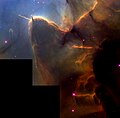Файл:Hs-1999-42-a-full jpg.jpg

Розмір при попередньому перегляді: 608 × 599 пікселів. Інші роздільності: 244 × 240 пікселів | 487 × 480 пікселів | 779 × 768 пікселів | 1039 × 1024 пікселів | 1516 × 1494 пікселів.
Повна роздільність (1516 × 1494 пікселів, розмір файлу: 1,59 МБ, MIME-тип: image/jpeg)
Історія файлу
Клацніть на дату/час, щоб переглянути, як тоді виглядав файл.
| Дата/час | Мініатюра | Розмір об'єкта | Користувач | Коментар | |
|---|---|---|---|---|---|
| поточний | 17:30, 1 березня 2010 |  | 1516 × 1494 (1,59 МБ) | Tryphon | Reverted to version as of 22:21, 8 May 2009: 1,516×1,494 px is the original resolution; anything bigger is just scaled-up. |
| 17:24, 1 березня 2010 |  | 3000 × 2957 (3,91 МБ) | Justass | resolution | |
| 22:21, 8 травня 2009 |  | 1516 × 1494 (1,59 МБ) | Fabian RRRR | {{Information |Description={{en|1=ABOUT THIS IMAGE: This NASA Hubble Space Telescope image of the Trifid Nebula reveals a stellar nursery being torn apart by radiation from a nearby, massive star. The picture also provides a peek at embryonic stars formi |
Використання файлу
Така сторінка використовує цей файл:
Глобальне використання файлу
Цей файл використовують такі інші вікі:
- Використання в af.wiki.x.io
- Використання в ar.wiki.x.io
- Використання в ast.wiki.x.io
- Використання в bg.wiki.x.io
- Використання в ca.wiki.x.io
- Використання в de.wiki.x.io
- Використання в el.wiki.x.io
- Використання в en.wiki.x.io
- Використання в en.wikibooks.org
- Використання в es.wiki.x.io
- Використання в fa.wiki.x.io
- Використання в fr.wiki.x.io
- Використання в hr.wiki.x.io
- Використання в hu.wiki.x.io
- Використання в id.wiki.x.io
- Використання в it.wiki.x.io
- Використання в ja.wiki.x.io
- Використання в ka.wiki.x.io
- Використання в lb.wiki.x.io
- Використання в mk.wiki.x.io
- Використання в ml.wiki.x.io
- Використання в mzn.wiki.x.io
- Використання в pl.wiki.x.io
- Використання в pt.wiki.x.io
- Використання в ru.wiki.x.io
- Використання в sh.wiki.x.io
- Використання в sv.wiki.x.io
- Використання в vi.wiki.x.io
- Використання в zh.wiki.x.io